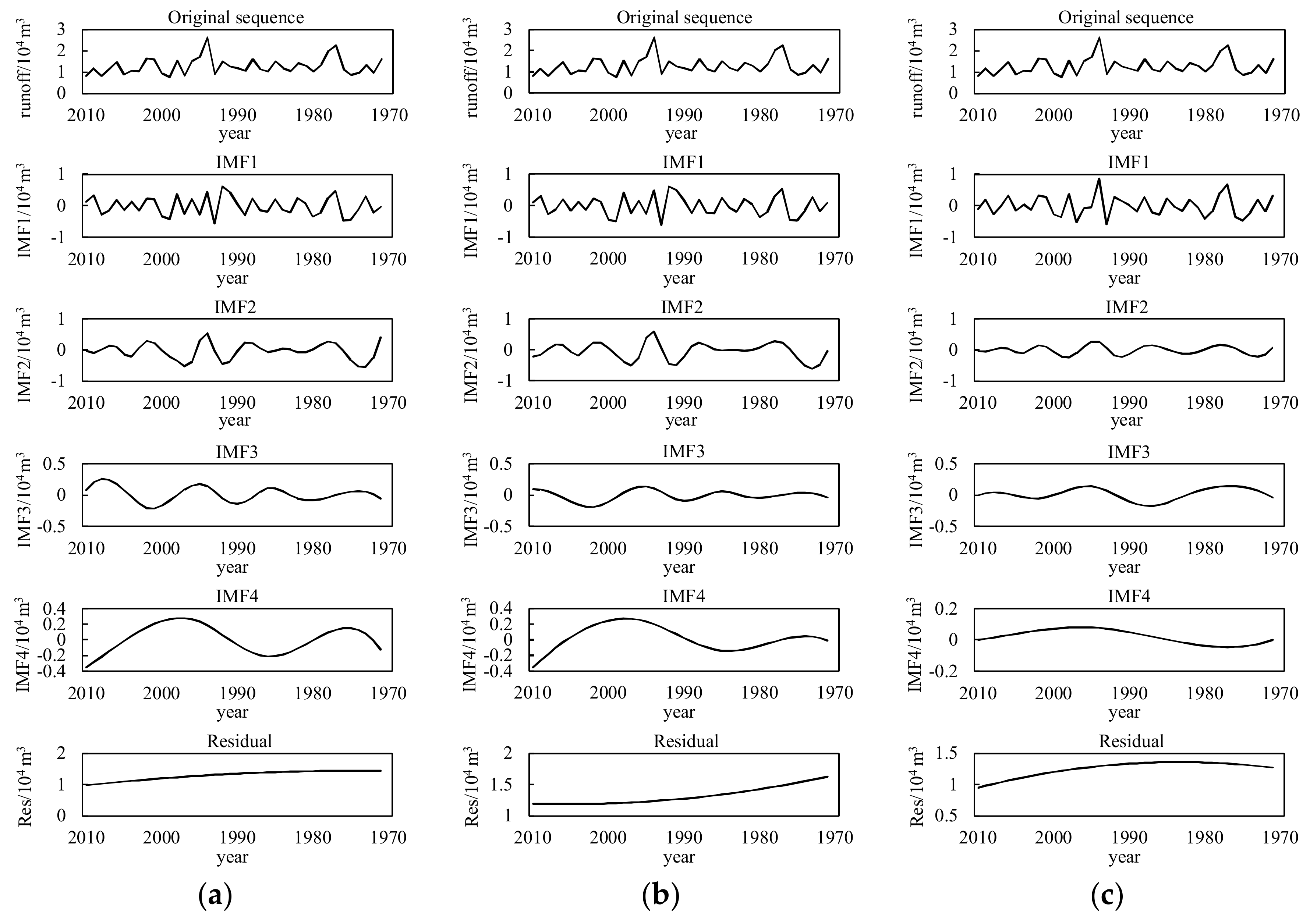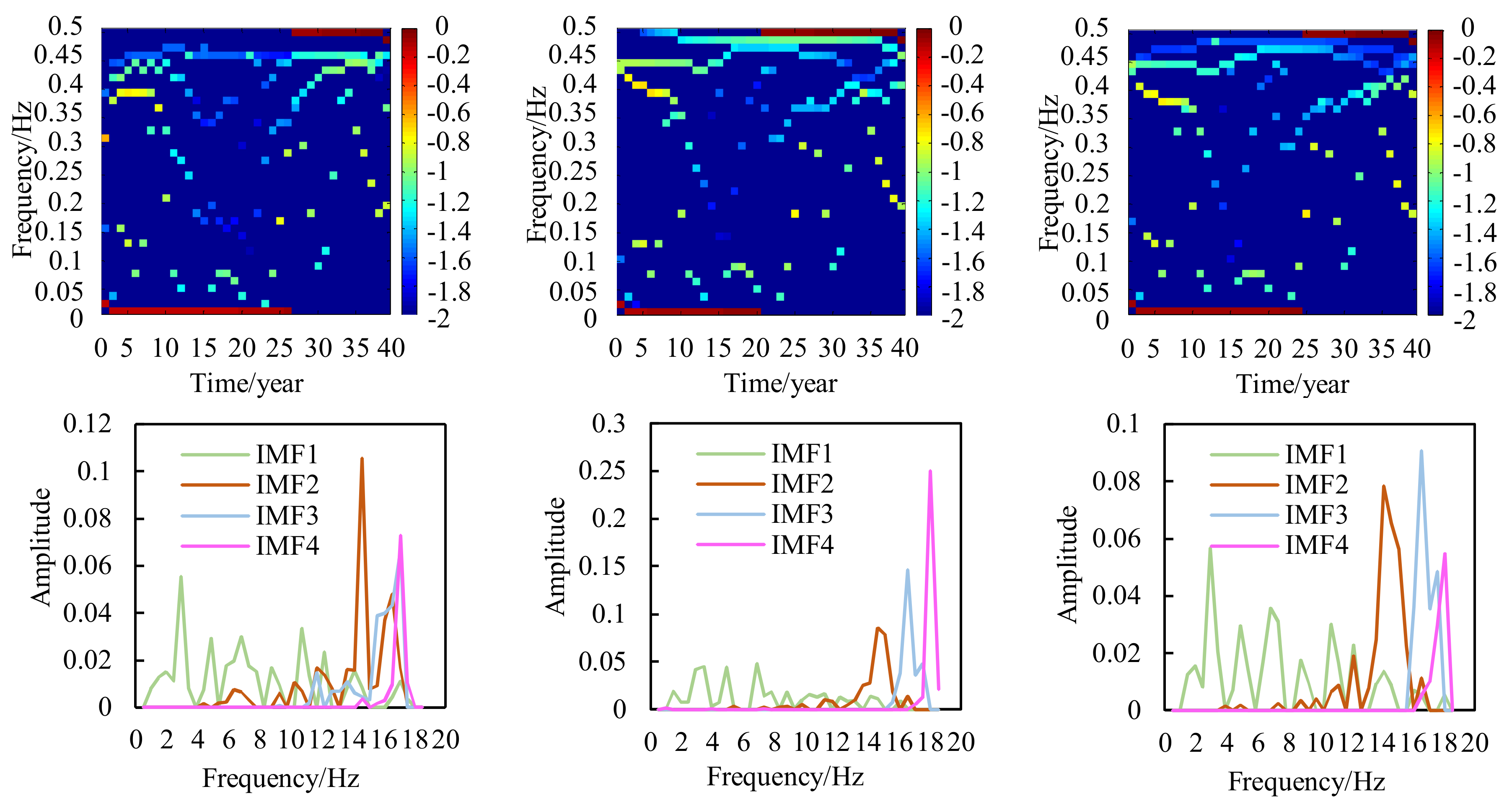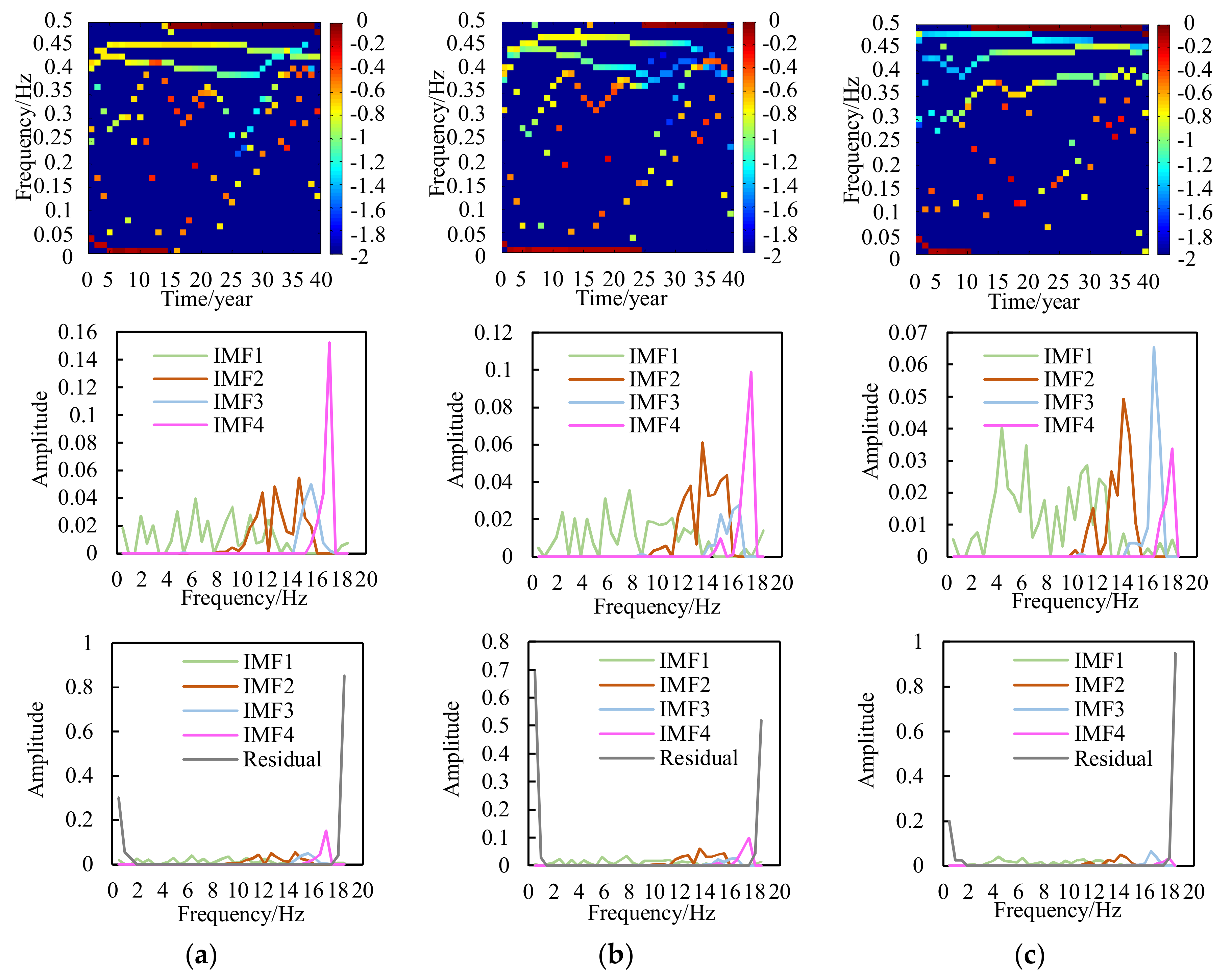Forward Prediction of Runoff Data in Data-Scarce Basins with an Improved Ensemble Empirical Mode Decomposition (EEMD) Model
Abstract
:1. Introduction
2. Materials and Methods
2.1. Empirical Mode Decomposition (EMD)
- Step 1: Identify all local maxima and minima in the original time series X(t). The upper and lower envelopes of the time series are obtained by cubic spline interpolation. The mean of the upper and lower enveloping lines is m(t):
- Step 2: A new series h(t) is calculated by subtracting the mean m(t) from the original series X(t):
- Step 3: The EMD sifting stopping criteria determines whether sifting should stop. If the stopping condition is met, h(t) is the IMF, and the next step is executed. If the stopping condition is not met, then h(t) is used as the original series, steps 1 and 2 are repeated until the stopping condition is met, and the first IMF, IMF1 c1(t), is calculated.
- Step 4: The residual series r1(t) is obtained by subtracting the IMF c1(t) from the original series X(t):
- Step 5: The residual series r1(t) is used as the new original series, and steps 1–4 are repeated. All the IMFs, c1(t), c2(t), …, cn(t), are decomposed until cn(t) is a monotonic or single-extreme-point residual.
2.2. EEMD
- Step 1: White noise ni(t) with a mean of 0 and standard deviation constant is added to the original signal X(t) multiple times. The standard deviation of the white noise is set to 0.1–0.4 times the standard deviation of the original signal (0.2 in this study):where Xi(t) represents the signal after the i-th addition of Gaussian white noise.
- Step 2: Each Xi(t) undergoes the EMD procedure. The IMF component obtained is denoted by cij(t), and the residual term is denoted by ri(t). Among them, cij(t) represents the j-th IMF from the decomposition of the signal after the i-th addition of Gaussian white noise.
- Step 3: Steps l and 2 are repeated N times. Based on the principle that the statistical mean of an uncorrelated random series is 0, the IMFs are subjected to an overall averaging operation to eliminate the impact of adding Gaussian white noise to the actual IMF multiple times. Finally, the IMF obtained from EEMD is as follows:where cj(t) represents the j-th IMF of the original signal obtained by EEMD. As the value of N increases, the sum of IMFs for the corresponding white noise approaches 0. At this point, the result of EEMD is as follows:where r(t) is the final residual, which represents the average trend of the signal. Any signal X(t) can be decomposed into multiple IMFs and one residual via EEMD. IMF cj(t) (j = 1, 2, …) represents the signal’s components from high frequency to low frequency. Each frequency contains distinct components and varies with the signal X(t).
2.3. Improved Ensemble Empirical Mode Decomposition (EEMD)
2.4. Improved EEMD-Based Decomposition-Prediction-Reconstruction Model
3. Results and Discussion
3.1. Case Selection
3.2. Calculation and Analysis
3.2.1. Improved EEMD
3.2.2. Radial Basis Function (RBF) Neural Network and Autoregression (AR) Model Prediction
3.3. Result Verification
4. Conclusions
Acknowledgments
Author Contributions
Conflicts of Interest
References
- Sivapalan, M.; Takeuchi, K.; Franks, S.W.; Gupta, V.K.; Karambiri, H.; Lakshmi, V.; Liang, X.; Mcdonnell, J.J.; Mendiondo, E.M.; O’Connell, P.E. Iahs decade on predictions in ungauged basins (pub), 2003-2012: Shaping an exciting future for the hydrological sciences. Int. Assoc. Sci. Hydrol. Bull. 2003, 48, 857–880. [Google Scholar] [CrossRef]
- Montanari, A.; Young, G.; Savenije, H.H.G.; Hughes, D.; Wagener, T.; Ren, L.L.; Koutsoyiannis, D.; Cudennec, C.; Toth, E.; Grimaldi, S. “Panta rhei-everything flows”: Change in hydrology and society-the iahs scientific decade 2013-2022. Int. Assoc. Sci. Hydrol. Bull. 2013, 58, 1256–1275. [Google Scholar] [CrossRef]
- Servat, E.; Dezetter, A. Rainfall-runoff modelling and water resources assessment in northwestern ivory coast. Tentative extension to ungauged catchments. J. Hydrol. 1993, 148, 231–248. [Google Scholar] [CrossRef]
- Mcintyre, N.; Lee, H.; Wheater, H.; Young, A.; Wagener, T. Ensemble predictions of runoff in ungauged catchments. Water Resour. Res. 2005, 41, 4203–4206. [Google Scholar] [CrossRef]
- Wan, Y.; Konyha, K. A simple hydrologic model for rapid prediction of runoff from ungauged coastal catchments. J. Hydrol. 2015, 528, 571–583. [Google Scholar] [CrossRef]
- Li, F.; Zhang, Y.; Xu, Z.; Liu, C.; Zhou, Y.; Liu, W. Runoff predictions in ungauged catchments in southeast tibetan plateau. J. Hydrol. 2014, 511, 28–38. [Google Scholar] [CrossRef]
- Liu, C.; Bai, P.; Wang, Z.; Liu, S.; Liu, X. Study on prediction of ungaged basins: A case study on the tibetan plateau. J. Hydraul. Eng. 2016, 47, 272–282. [Google Scholar]
- Besaw, L.E.; Rizzo, D.M.; Bierman, P.R.; Hackett, W.R. Advances in ungauged streamflow prediction using artificial neural networks. J. Hydrol. 2010, 386, 27–37. [Google Scholar] [CrossRef]
- Mohamoud, Y. Prediction of daily flow duration curves and streamflow for ungauged catchments using regional flow duration curves. Int. Assoc. Sci. Hydrol. Bull. 2008, 53, 706–724. [Google Scholar] [CrossRef]
- Gazzaz, N.M.; Yusoff, M.K.; Aris, A.Z.; Juahir, H.; Ramli, M.F. Artificial neural network modeling of the water quality index for kinta river (malaysia) using water quality variables as predictors. Mar. Pollut. Bull. 2012, 64, 2409–2420. [Google Scholar] [CrossRef] [PubMed]
- Kalin, L.; Isik, S.; Schoonover, J.E.; Lockaby, B.G. Predicting water quality in unmonitored watersheds using artificial neural networks. J. Environ. Qual. 2010, 39, 1429–1440. [Google Scholar] [CrossRef] [PubMed]
- Noori, N.; Kalin, L. Coupling swat and ann models for enhanced daily streamflow prediction. J. Hydrol. 2016, 533, 141–151. [Google Scholar] [CrossRef]
- Palani, S.; Tkalich, P.; Balasubramanian, R.; Palanichamy, J. Ann application for prediction of atmospheric nitrogen deposition to aquatic ecosystems. Mar. Pollut. Bull. 2011, 62, 1198–1206. [Google Scholar] [CrossRef] [PubMed]
- Sahoo, G.B.; Ray, C.; Carlo, E.H.D. Use of neural network to predict flash flood and attendant water qualities of a mountainous stream on oahu, hawaii. J. Hydrol. 2006, 327, 525–538. [Google Scholar] [CrossRef]
- Asefa, T.; Kemblowski, M.; Mckee, M.; Khalil, A. Multi-time scale stream flow predictions: The support vector machines approach. J. Hydrol. 2006, 318, 7–16. [Google Scholar] [CrossRef]
- Jajarmizadeh, M.; Lafdani, E.K.; Harun, S.; Ahmadi, A. Application of svm and swat models for monthly streamflow prediction, a case study in south of iran. KSCE J. Civ. Eng. 2015, 19, 345–357. [Google Scholar] [CrossRef]
- Kalra, A.; Ahmad, S. Using oceanic-atmospheric oscillations for long lead time streamflow forecasting. Water Resour. Res. 2009, 45, 450–455. [Google Scholar] [CrossRef]
- Noori, R.; Karbassi, A.R.; Moghaddamnia, A.; Han, D.; Zokaei-Ashtiani, M.H.; Farokhnia, A.; Gousheh, M.G. Assessment of input variables determination on the svm model performance using pca, gamma test, and forward selection techniques for monthly stream flow prediction. J. Hydrol. 2011, 401, 177–189. [Google Scholar] [CrossRef]
- Manuca, R.; Savit, R. Stationarity and nonstationarity in time series analysis. Phys. D Nonlinear Phenom. 1996, 99, 134–161. [Google Scholar] [CrossRef]
- Trenberth, K.E. Recent observed interdecadal climate changes in the northern hemisphere. Bull. Am. Meteorol. Soc. 1990, 71, 377–390. [Google Scholar] [CrossRef]
- Tsonis, A.A. Widespread increases in low-frequency variability of precipitation over the past century. Nature 1996, 382, 700–702. [Google Scholar] [CrossRef]
- Kumar, P.; Foufoula-Georgiou, E. A multicomponent decomposition of spatial rainfall fields: 1. Segregation of large- and small-scale features using wavelet transforms. Water Resour. Res. 1993, 29, 2515–2532. [Google Scholar] [CrossRef]
- Saco, P.; Kumar, P. Coherent modes in multiscale variability of streamflow over the united states. Water Resour. Res. 2000, 36, 1049–1068. [Google Scholar] [CrossRef]
- Sang, Y.F.; Wang, Z.; Liu, C. Discrete wavelet-based trend identification in hydrologic time series. Hydrol. Process. 2013, 27, 2021–2031. [Google Scholar] [CrossRef]
- Wang, W.; Jing, D. Wavelet network model and its application to the prediction of hydrology. Nat. Sci. 2003, 1, 67–71. [Google Scholar]
- Huang, N.E.; Shen, Z.; Long, S.R.; Wu, M.C.; Shih, H.H.; Zheng, Q.; Yen, N.C.; Chi, C.T.; Liu, H.H. The empirical mode decomposition and the hilbert spectrum for nonlinear and non-stationary time series analysis. Proc. Math. Phys. Eng. Sci. 1998, 454, 903–995. [Google Scholar] [CrossRef]
- Sang, Y.F.; Wang, Z.; Liu, C. Comparison of the mk test and emd method for trend identification in hydrological time series. J. Hydrol. 2014, 510, 293–298. [Google Scholar] [CrossRef]
- Sang, Y.F.; Wang, Z.; Liu, C. Period identification in hydrologic time series using empirical mode decomposition and maximum entropy spectral analysis. J. Hydrol. 2012, s 424–425, 154–164. [Google Scholar] [CrossRef]
- Huang, Y.; Schmitt, F.G.; Lu, Z.; Liu, Y. Analysis of daily river flow fluctuations using empirical mode decomposition and arbitrary order hilbert spectral analysis. J. Hydrol. 2009, 373, 103–111. [Google Scholar] [CrossRef]
- Li, X.; Ding, Z. Emd method for multiple time-scale analysis on fluctuation characteristic of natural annual runoff time series of fen river. Water Resour. Power 2008, 30–32. [Google Scholar]
- Huang, S.; Chang, J.; Huang, Q.; Chen, Y. Monthly streamflow prediction using modified emd-based support vector machine. J. Hydrol. 2014, 511, 764–775. [Google Scholar] [CrossRef]
- Karthikeyan, L.; Kumar, D.N. Predictability of nonstationary time series using wavelet and emd based arma models. J. Hydrol. 2013, 502, 103–119. [Google Scholar] [CrossRef]
- Zhang, H.; Singh, V.P.; Wang, B.; Yu, Y. Ceref: A hybrid data-driven model for forecasting annual streamflow from a socio-hydrological system. J. Hydrol. 2016, 540, 246–256. [Google Scholar] [CrossRef]
- Huang, N.E. A study of the characteristics of white noise using the empirical mode decomposition method. Proc. Math. Phys. Eng. Sci. 2004, 460, 1597–1611. [Google Scholar]
- Wu, Z.; Huang, N.E. Ensemble empirical mode decomposition: A noise-assisted data analysis method. Adv. Adapt. Data Anal. 2005, 1, 1–41. [Google Scholar] [CrossRef]
- Huang, N.E.; Shen, Z.; Long, S.R. A new view of nonlinear water waves: The hilbert spectrum1. Ann. Rev. Fluid Mech. 1999, 31, 417–457. [Google Scholar] [CrossRef]
- Gabriel, R.; Patrick, F.; Paulo, G. On empirical mode decomposition and its algorithms. In Proceedings of the IEEE-EURASIP Workshop on Nonlinear Signal and Image Processing (NSIP-03), Grado, Italy, 8–11 June 2003. [Google Scholar]
- Cheng, J. Research on Fault Diagnosis Methods for Rotating Machinery Based on Hilbert-Huang Transform; Hunan University: Changsha, China, 2005. [Google Scholar]
- Pan, W. Akaike’s information criteria in generalized estimating equations. Biometrics 2001, 57, 120–125. [Google Scholar] [CrossRef] [PubMed]
- Ahmed, N.; Rao, K.R.; Debnath, L. Orthogonal transforms for digital signal processing. IEEE Trans. Syst. Man Cybern. 1976, 9, 66–67. [Google Scholar] [CrossRef]
- Li, X. Study on Orthogonality of Emd Method in Hht; Kunming University Of Science And Technology: Kunming, China, 2010. [Google Scholar]





| Orthogonality Index | Zhaoshiyao Station | Suide Station | ||||
|---|---|---|---|---|---|---|
| SD Criteria | GR Criteria | MTED | SD Criteria | GR Criteria | MTED | |
| Without residual | −0.10 | −0.10 | −0.08 | −1.24 | −0.95 | −0.23 |
| With residual | −1.72 | −3.57 | −0.66 | −8.63 | −9.86 | −5.64 |
| Error Evaluation Index | Zhaoshiyao Station | Suide Station | ||||
|---|---|---|---|---|---|---|
| SD Criteria | GR Criteria | MTED | SD Criteria | GR Criteria | MTED | |
| Relative average deviation (RAD)/% | 9.45 | 9.39 | 6.86 | 25.24 | 25.60 | 11.10 |
| Nash–Sutcliffe efficiency (NSE) | 0.19 | −0.24 | 0.40 | 0.34 | 0.29 | 0.89 |
| Error Evaluation Index | Zhaoshiyao Station | Suide Station | ||||
|---|---|---|---|---|---|---|
| AR Model Method | Rainfall-Runoff Method | Improved EEMD Prediction Model | AR Model Method | Rainfall-Runoff Method | Improved EEMD Prediction Model | |
| RAD/% | 11.03 | 15.13 | 6.86 | 27.76 | 19.67 | 11.10 |
| NSE | −0.87 | −1.54 | 0.40 | −0.02 | −0.11 | 0.89 |
| Statistical Parameters | Zhaoshiyao Station | Suide Station | ||||
|---|---|---|---|---|---|---|
| Mean | Mean Square Error | Coefficient of Variation | Mean | Mean Square Error | Coefficient of Variation | |
| Original sequence | 3.86 | 0.51 | 0.13 | 1.28 | 0.40 | 0.31 |
| Improved EEMD prediction model | 3.84 | 0.44 | 0.11 | 1.29 | 0.39 | 0.30 |
| Rainfall-runoff method | 3.70 | 0.38 | 0.10 | 1.22 | 0.33 | 0.27 |
| AR model | 3.75 | 0.37 | 0.10 | 1.26 | 0.33 | 0.26 |
© 2018 by the authors. Licensee MDPI, Basel, Switzerland. This article is an open access article distributed under the terms and conditions of the Creative Commons Attribution (CC BY) license (http://creativecommons.org/licenses/by/4.0/).
Share and Cite
Yu, Y.; Zhang, H.; Singh, V.P. Forward Prediction of Runoff Data in Data-Scarce Basins with an Improved Ensemble Empirical Mode Decomposition (EEMD) Model. Water 2018, 10, 388. https://doi.org/10.3390/w10040388
Yu Y, Zhang H, Singh VP. Forward Prediction of Runoff Data in Data-Scarce Basins with an Improved Ensemble Empirical Mode Decomposition (EEMD) Model. Water. 2018; 10(4):388. https://doi.org/10.3390/w10040388
Chicago/Turabian StyleYu, Yinghao, Hongbo Zhang, and Vijay P. Singh. 2018. "Forward Prediction of Runoff Data in Data-Scarce Basins with an Improved Ensemble Empirical Mode Decomposition (EEMD) Model" Water 10, no. 4: 388. https://doi.org/10.3390/w10040388
APA StyleYu, Y., Zhang, H., & Singh, V. P. (2018). Forward Prediction of Runoff Data in Data-Scarce Basins with an Improved Ensemble Empirical Mode Decomposition (EEMD) Model. Water, 10(4), 388. https://doi.org/10.3390/w10040388







